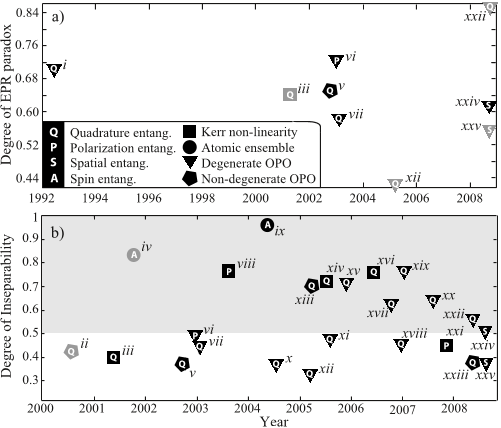




Did you find this useful? Give us your feedback














831 citations
538 citations
387 citations
351 citations
[...]
327 citations
...Steering inequalities based on uncertainty relations have been proposed already long before the formal definition of steerability in the context of the EPR argument (Reid, 1989; Reid et al., 2009)....
[...]
...First, a review on the quantitative aspects of the EPR argument can be found in (Reid et al., 2009)....
[...]
13,778 citations
...Outlook 22A knowledgments 22Referen es 23I. INTRODUCTIONIn 1935, Einstein, Podolsky and Rosen (EPR) origi-nated the famous EPR paradox (Einstein et al. (1935))....
[...]
...This isa demonstration of the EPR paradox in the manner pro-posed in Einstein et al. (1935)....
[...]
11,600 citations
...This form of remote ommuni ation of quantuminformation using only entanglement and lassi al infor-mation was proposed by Bennett et al. (1993) for dis- rete variables....
[...]
6,999 citations
...The entanglement of formation leads to the popular on- urren e measure for two qubits (Wootters (1998))....
[...]
6,887 citations
...Further Bell and CHSH in-equalities (Clauser et al. (1969); Bell (1971); Clauser and Horne(1974)) were derived that allow for a sto hasti predetermin-ism, where lo al hidden variables give probabilisti predi tionsfor measurements....
[...]
...Su h probability distributions are also impli it in theextensions by Clauser et al. (1969) and Bell (1988) ofBell's theorem to systems of less-than-ideal orrelation....
[...]
...The seminal works of Bell (1964, 1988) and Clauser et al.(1969) (CHSH) lari ed this issue, to show that this spe -ulation was wrong....
[...]
5,110 citations
...After Bohm (1952) demonstrated that a (non-lo al)hidden-variable theory was feasible, subsequent work byBell (1964) proved the impossibility of ompleting quan-tum me hani s with lo al hidden variable theories....
[...]
In these steady-state continuous-wave experiments, however, the squeezing parameter r is time independent, and given by the inputoutput parametric gain G, such that G=e2r.
Due to the high peak powers of the frequency doubled pulses as well as the particular choice of a highly nonlinear optical material KNBO3 , the use of a cavity was circumvented despite the fact that a very thin 100 m crystal was employed.
Using fieldquadrature measurements and multiparticle states, it is likely that quantum theory and its alternatives can be tested for increasingly macroscopic systems Marshall et al., 2003 using the EPR paradox.
A degenerate waveguide technique, together with a beam splitter, was recently used to demonstrate pulsed entanglement using a traveling-wave OPA Zhang et al., 2007 .
One might expect that since spin-squeezed and entangled atomic ensembles contain a large number N of atoms, the decoherence rate of such systems would scale as N , where is the single-atom decay rate.
a critical feature of these collective spin states is that excitation due to interaction with light is distributed symmetrically amongst all of the atoms.
A well-accepted measure of teleportation efficacy is the overlap of the wave function of the output state with the original input state.
Since the set of predicted distributions are the conditionals P x xB , one for each value of xB, the logical choice is to label the element of reality by the outcomes xB, but bearing in mind the set of predetermined results is not the set xB , but is the set of associated conditional distributions P x xB .
For a Gaussian distribution of coherent states, with mean photon number n̄, the average fidelity using classical measure and regenerate strategies is limited to F n̄+1 / 2n̄+1
The quantum noise properties were characterized at a specific Fourier component within a narrow frequency band, typically in the range 100–300 kHz.
The first experimental realization of pulsed EPR entanglement, shown in Fig. 7, was based on the approach of mixing two squeezed beams on a 50/50 beam splitteras outlined above for continuous wave light.
The symmetry of the entangled beams allowed one to infer from this number the degree of EPR violation, which was found to be 2=0.64±0.08.
These techniques have significant potential for quantum information networks Duan et al., 2001 and are also capable of generating a collective entangled state of the form required to test the EPR paradox.
The other approach to experimental demonstration of collective spin entanglement in atomic ensembles is to rely on conditioning measurements to prepare the state Julsgaard et al., 2004; Chou et al., 2005 .
The optimum level of EPR paradox achieved to date was by Bowen, Schnabel, et al. 2003 using a pair of type The authoroptical parametric oscillators.
The first experimental demonstration of quantum state transfer from the polarization state of an optical field to the collective spin state of an atomic ensemble was performed by Hald et al.